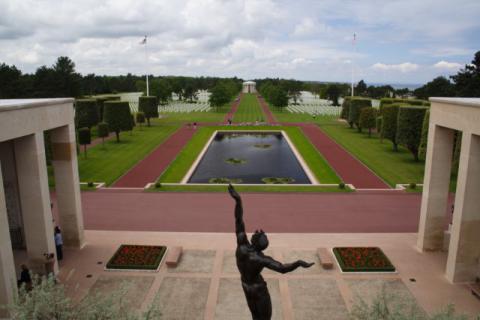The American Battle Monuments Commission (ABMC) Normandy American Cemetery sits on a bluff overlooking Omaha Beach, also known as “Bloody Omaha”, where part of the Normandy landings happened on June 6, 1944. But, besides the more than 10,000 service members commemorated or memorialized there, are you sure to know everything about this quite well-known site? Here are five things you may not know about Normandy American Cemetery.
A permanent resting place
The cemetery is built on the site of the temporary American St. Laurent Cemetery, established by the U.S. First Army on June 8, 1944, as the first American cemetery in Northwest Europe in World War II. It was formed into a permanent site through the consolidation of ten temporary cemeteries in the region established during Operation Overlord and the campaign inland.
The last burial
The most recent burial at the Normandy American Cemetery happened on July 9, 2022. Second Lt. William J. McGowan, a U.S. Army Air Forces pilot who was killed on D-Day, was buried there almost 80 years after his death. His remains were discovered during the excavation of his crash site, and officially accounted for on May 13, 2019. While the cemetery is closed to burials, the next of kin of individuals like McGowan whose missing remains are later identified are able to choose interment at the cemetery.
Brothers in rest
There is one World War I aviator killed in action buried at Normandy American Cemetery, which is almost entirely made up of those who lost their lives on D-Day or during ensuing operations. Quentin Roosevelt, the youngest son of President Theodore Roosevelt, was killed in aerial combat in 1918. After construction of the permanent cemetery, Quentin’s remains were reinterred at Normandy[1] to lie in rest beside his brother, Brig. Gen. Theodore Roosevelt Jr. Theodore was 56-years old when he led the assault on Utah Beach on D-Day, for which he was awarded the Medal of Honor. He died of a heart attack in France in 1944 roughly a month after the invasion.
Commemoration through art
At the far end of the cemetery, granite statues stand at either end of a small hemicycle. On one side, the statue of Columbia, representing the U.S., is holding an eagle. On the other side, the statue of Marianne, representing France, is holding a rooster. Both allegorical figures of the two nations are holding olive branches, a symbol of peace. Those two figures are also present on the roof of the chapel.
Frozen in time
On June 6, 1969, a time capsule was buried at the cemetery embedded in the lawn directly opposite the entrance to the site’s administration building. The sealed capsule is covered by a pink granite slab and is dedicated to Eisenhower, and contains news reports of the Normandy landings. It will be opened on June 6, 2044, on the hundredth anniversary of the allied landings along Normandy’s shores.
The ABMC’s mission is to honor the service of the Armed Forces by creating and maintaining memorial sites, offering commemorative services, and facilitating the education of their legacy to future generations. It was founded in 1923 following World War I and its 26 cemeteries and 31 monuments honor the service men and women who fought and perished during World War I (WWI), World War II (WWII), the Korean War and the Vietnam War, as well as some who fought during the Mexican-American War.
Those sites are a constant reminder of Gen. John J. Pershing’s promise that “time will not dim the glory of their deeds”.
[1] At his father’s request, Quentin was left where he was initially buried and then was moved after WWII at the request of Theodore Jr.’s widow (an ABMC Commissioner). The agency allowed it on the condition that the family paid for the cost of moving the remains.

Source: American Battle Monuments Commission
 An official website of the United States government. Here's how you know.
An official website of the United States government. Here's how you know. 